Three-Dimensional Numerical Investigations of the Flow Pattern and Evolution of the Horseshoe Vortex at a Circular Pier during the Development of a Scour Hole
Abstract
:Featured Application
Abstract
1. Introduction
- Selecting an appropriate turbulence model with personal computer computational resources that can simulate the case in hand with acceptable accuracy, since no agreement between researchers has been achieved yet;
- Tracking the flow structure and bed shear stress variations during the development of a scour hole with the maximum achievable number of development stages. The morphological dimensions for the development stages (seven stages) of the scour hole were collected from previous studies.
2. Materials and Methods
3. Results and Discussion
3.1. Velocity Field Description
3.2. Horseshoe Vortex
3.3. Bed Shear Stress
4. Conclusions
- The reversal longitudinal flow reached a maximum value of at and reduced to at the equilibrium scour stage;
- The maximum positive values of the lateral velocity remained almost constant in the order of about during the souring process and reached 0.0 at the bottom level;
- The downward vertical velocity increased with the progress of the scour hole until reaching its maximum value of at ;
- As the scour hole developed, the HV vortex sunk into the scour hole and was kept contained within its boundaries.
Author Contributions
Funding
Institutional Review Board Statement
Informed Consent Statement
Data Availability Statement
Conflicts of Interest
Abbreviations
| area; | |
| area fraction opened to flow in rectangular Cartesian coordinates; | |
| horseshoe vortex major and minor radiuses; | |
| CFD | computational fluid dynamics; |
| D | pier diameter; |
| horseshoe vortex mean size; | |
| median diameter of sediment particles size distribution; | |
| DES | detached eddy simulation; |
| scour depth; | |
| equilibrium scour depth; | |
| the differential displacement vector along with a closed curve C. | |
| fluid volume of fraction; | |
| viscous acceleration in (x, y, and z) directions; | |
| water body acceleration in (x, y, and z) directions; | |
| normal water depth in the current study (30 cm); | |
| horseshoe vortex; | |
| k | turbulent kinetic energy in turbulence models; |
| LES | large eddy simulation; |
| flux vector; | |
| t | time; |
| depth averaged approach velocity; | |
| instantaneous velocity components in rectangular Cartesian coordinates; | |
| shear velocity; | |
| opened fraction volume to flow; | |
| velocity vector; | |
| x,y,z | rectangular Cartesian coordinates; |
| z | the distance from the cell centroid to the wall; |
| dimensionless parameter for the wall function; | |
| turbulent energy dissipation rate in model; | |
| kinematic viscosity; | |
| the fluid density | |
| cell size in rectangular Cartesian coordinates; | |
| Standard deviation of sediment particles size; | |
| time Step; | |
| bed shear stress; | |
| critical bed shear stress; | |
| the maximum bed shear stress at equilibrium scour hole; | |
| turbulent energy dissipation rate in model; | |
| x, and y vorticities; | |
| area-averaged dimensionless circulation coefficient; and | |
| rotation |
References
- Laursen, E.M.; Toch, A. Scour around Bridge Piers and Abutments; Bulletin No. 4; Iowa Highway Research Board (IHRB): Iowa, IA, USA, 1956. [Google Scholar]
- Shen, H.W.; Schneider, V.R.; Karaki, S. Local Scour Around Bridge Piers. J. Hydraul. Div. ASCE 1969, 95, 1919–1940. [Google Scholar] [CrossRef]
- Breusers, H.N.C.; Nicollet, G.; Shen, H.W. Local Scour Around Cylindrical Piers. J. Hydraul. Res. 1977, 15, 211–252. [Google Scholar] [CrossRef]
- Jain, S.C.; Fischer, E.E. Scour around Circular Bridge Piers at High Froude Numbers; FHWA Report No. FHWA-RD-79-104; FHWA: Washington, DC, USA, 1979. [Google Scholar]
- Melville, B.W. Local Scour at Bridge Abutments. J. Hydraul. Eng. 1992, 118, 615–631. [Google Scholar] [CrossRef]
- Richardson, E.V.; Harrison, L.I.; Richardson, J.R.; Davis, S.R. Evaluating Scour at Bridges; Hydraulic Engineering Circular No. 18 (HEC-18); Federal Highway Administration, U.S. Department of Transportation: Washington, DC, USA, 1993. [Google Scholar]
- Melville, B.W. Pier and abutment scour: Integrated approach. J. Hydraul. Eng. 1997, 123, 125–136. [Google Scholar] [CrossRef]
- Sheppard, D.M.; Miller, W.J. Live-bed local pier scour experiments. J. Hydraul. Eng. 2006, 132, 635–642. [Google Scholar] [CrossRef] [Green Version]
- Yanmaz, A.M.; Altinbilek, H.D. Study of time-dependent local scour around bridge piers. J. Hydraul. Eng. 1991, 117, 1247–1268. [Google Scholar] [CrossRef]
- Sheppard, D.M.; Huseyin, D.; Melville, B.W. Scour at Wide Piers and Long Skewed Piers; The National Academies Press: Washington, DC, USA, 2011. [Google Scholar]
- Melville, B.W.; Sutherland, A.J. Design Method for Local Scour at Bridge Piers. J. Hydraul. Eng. 1988, 114, 1210–1226. [Google Scholar] [CrossRef]
- Raudkivi, B.A.J. Functional Trends of Scour at Bridge Piers. J. Hydraul. Div. 1986, 112, 1–13. [Google Scholar] [CrossRef]
- Chiew, Y.-M. Scour protection at bridge piers. J. Hydraul. Eng. 1992, 118, 1260–1269. [Google Scholar] [CrossRef]
- Melville, B.W. Local Scour at Bridge Sites. Ph.D. Thesis, University of Auckland, Auckland, New Zealand, 1975. [Google Scholar]
- Ahmed, F.; Rajaratnam, N. Flow around bridge piers. J. Hydraul. Eng. 1998, 124, 288–300. [Google Scholar] [CrossRef]
- Graf, W.H.; Istirato, L. Flow pattern in the scour hole around a cylinder. J. Hydraul. Res. 2002, 40, 13–20. [Google Scholar] [CrossRef]
- Dey, S.; Raikar, R.V. Characteristics of horseshoe vortex in developing scour holes at piers. J. Hydraul. Eng. 2007, 133, 399–413. [Google Scholar] [CrossRef]
- Subhasish, D.; Rajib, D.; Mazumdar, A. Circulation characteristics of horseshoe vortex in scour region around circular piers. Water Sci. Eng. 2013, 6, 59–77. [Google Scholar] [CrossRef]
- Istirato, L. Experiments on Flow around a Cylinder in a Scoured Channel Bed; Engineering Federal Institute of Technology in Lausanne: Lausanne, Switzerland, 2001. [Google Scholar]
- Dargahi, B. Flow Field and Local Scouring around a Pier; Bulletin No. TRITA-VBI-137; The Royal Institute of Technology: Stockholm, Sweden, 1987. [Google Scholar]
- Melville, B.W.; Raudkivi, A.J. Flow characteristics in local scour at bridge piers. J. Hydraul. Res. 1977, 15, 373–380. [Google Scholar] [CrossRef]
- Richardson, J.E.; Panchang, V.G. Three dimensional simulation of scour-inducing flow at bridge piers. J. Hydraul. Eng. 1998, 124, 530–540. [Google Scholar] [CrossRef]
- Xiang, Q.; Wei, K.; Li, Y.; Zhang, M.; Qin, S. Experimental and Numerical Investigation of Local Scour for Suspended Square Caisson under Steady Flow. KSCE J. Civ. Eng. 2020. [Google Scholar] [CrossRef]
- Bao, Y.; Wu, Q.; Zhou, D. Computers & Fluids Numerical investigation of flow around an inline square cylinder array with different spacing ratios. Comput. Fluids 2012, 55, 118–131. [Google Scholar] [CrossRef]
- Akbari, M.H.; Price, S.J. Numerical investigation of flow patterns for staggered cylinder pairs in cross-flow. J. Fluids Struct. 2005, 20, 533–554. [Google Scholar] [CrossRef]
- Beheshti, A.A.; Ataie-Ashtiani, B.; Dashtpeyma, H. Numerical simulations of turbulent flow around side-by-side circular piles with different spacing ratios. Int. J. River Basin Manag. 2017, 15, 227–238. [Google Scholar] [CrossRef]
- Bosch, G.; Rodi, W. Simulation of vortex shedding past a square cylinder with different turbulence models. Int. J. Numer. Methods Fluids 1998, 28, 601–616. [Google Scholar] [CrossRef]
- Zhi-wen, Z.; Zhen-qing, L. CFD prediction of local scour hole around bridge piers. J. Cent. South Univ. 2012, 19, 273–281. [Google Scholar] [CrossRef]
- Azhari, A.; Saghravani, S.F.; Mohammadnezhad, B.A. 3D Numerical modelling of local scour around the cylindrical bridge piers. In Proceedings of the XVIII International Conference on Water Resources, Barcelona, Spain, 21–24 June 2010. [Google Scholar]
- Roulund, A.; Sumer, B.M.; Fredsoe, J.; Michelsen, J. Numerical and experimental investigation of flow and scour around a circular pile. J. Fluid Mech. 2005, 534, 351–401. [Google Scholar] [CrossRef]
- Baykal, C.; Sumer, B.M.; Fuhrman, D.R.; Jacobsen, N.G.; Fredsøe, J. Numerical investigation of flow and scour around a vertical circular cylinder. Philos. Trans. R. Soc. 2015. [Google Scholar] [CrossRef] [Green Version]
- Salaheldin, T.M.; Imran, J.; Chaudhry, M.H. Numerical Modeling of Three-Dimensional Flow Field Around Circular Piers. J. Hydraul. Eng. 2004, 130, 91–100. [Google Scholar] [CrossRef]
- Ali, K.H.M.; Karim, O. Simulation of flow around piers. J. Hydraul. Res. 2002, 40, 161–174. [Google Scholar] [CrossRef]
- Gopalan, H.; Jaiman, R. Journal of Wind Engineering Numerical study of the flow interference between tandem cylinders employing non-linear hybrid URANS—LES methods. J. Wind Eng. Ind. Aerodyn. 2015, 142, 111–129. [Google Scholar] [CrossRef]
- Palau-Salvador, G.; Stoesser, T.; Rodi, W. LES of the flow around two cylinders in tandem. J. Fluids Struct. 2008, 24, 1304–1312. [Google Scholar] [CrossRef] [Green Version]
- Kirkil, G.; Constantinescu, S.G.; Ettema, R. Coherent Structures in the Flow Field around a Circular Cylinder with Scour Hole. J. Hydraul. Eng. 2008, 134, 572–587. [Google Scholar] [CrossRef]
- Kirkil, G.; Constantinescu, G.; Ettema, R. Detached Eddy Simulation Investigation of Turbulence at a Circular Pier with Scour Hole. J. Hydraul. Eng. 2009, 135, 888–901. [Google Scholar] [CrossRef]
- Kirkil, G.; Constantinescu, G. Nature of flow and turbulence structure around an in-stream vertical plate in a shallow channel and the implications for sediment erosion. J. Water Resour. Res. 2009, 45, 1–18. [Google Scholar] [CrossRef]
- Kirkil, G.; Constantinescu, G. Effects of cylinder Reynolds number on the turbulent horseshoe vortex system and near wake of a surface-mounted circular cylinder. Phys. Fluids 2015, 27. [Google Scholar] [CrossRef] [Green Version]
- Wang, D.; Shao, S.; Li, S.; Shi, Y.; Arikawa, T.; Zhang, H. 3D ISPH erosion model for flow passing a vertical cylinder. J. Fluids Struct. 2018, 78, 374–399. [Google Scholar] [CrossRef]
- Kazemi, E.; Tait, S.; Shao, S. SPH-based numerical treatment of the interfacial interaction of flow with porous media. Int. J. Numer. Methods Fluids 2020, 92, 219–245. [Google Scholar] [CrossRef]
- Kazemi, E.; Koll, K.; Tait, S.; Shao, S. SPH modelling of turbulent open channel flow over and within natural gravel beds with rough interfacial boundaries. Adv. Water Resour. 2020, 140, 103557. [Google Scholar] [CrossRef]
- Ettema, R.; Constantinescu, G.; Melville, B.W. Flow-Field Complexity and Design Estimation of Pier-Scour Depth: Sixty Years since Laursen and Toch. J. Hydraul. Eng. 2017, 143, 1–14. [Google Scholar] [CrossRef]
- Flow-3D User Manual; Flow Sience Inc.: Santa Fe, NM, USA, 2016.
- Hirt, C.W.; Nichols, B.D. Volume of fluid (VOF) method for the dynamics of free boundaries. J. Comput. Phys. 1981, 39, 201–225. [Google Scholar] [CrossRef]
- Link, O.; Pfleger, F.; Zanke, U. Characteristics of developing scour-holes at a sand-embedded cylinder. Int. J. Sediment Res. 2008, 23, 258–266. [Google Scholar] [CrossRef]
- Chang, W.; Constantinescu, G.; Lien, H.; Tsai, W.; Lai, J.; Loh, C. Flow Structure around Bridge Piers of Varying Geometrical Complexity. J. Hydraul. Eng. 2013, 139, 812–826. [Google Scholar] [CrossRef]
- Menter, F.R. Zonal Two-Equation k-ω Turbulence Models for Aerodynamic Flows. In Proceedings of the 23rd Fluid Dynamics, Plasmadynamics, and Lasers Conference, Orlando, FL, USA, 6–9 July 1993; 1993; pp. 1–21. [Google Scholar] [CrossRef]
- Muzzammil, M.; Gangadhariah, T. The mean characteristics of horseshoe vortex at a cylindrical pier. J. Hydraul. Res. 2003, 41, 285–297. [Google Scholar] [CrossRef]
- Berenbrock, C.; Tranmer, A.W. Simulation of Flow, Sediment Transport, and Sediment Mobility of the Lower Coeur d’Alene River, Idaho; Scientific Investigations Report 2008-5093; U.S. Geological Survey (USGS): Reston, VA, USA, 2008. [Google Scholar]
- Mendoza-Cabrales, C. Computation of Flow Past a Cylinder Mounted on a Flat Plate. In Proceedings of the National Conference of Hydraulic Engineering, San Francisco, CA, USA, 25–30 July 1993; pp. 899–904. [Google Scholar]
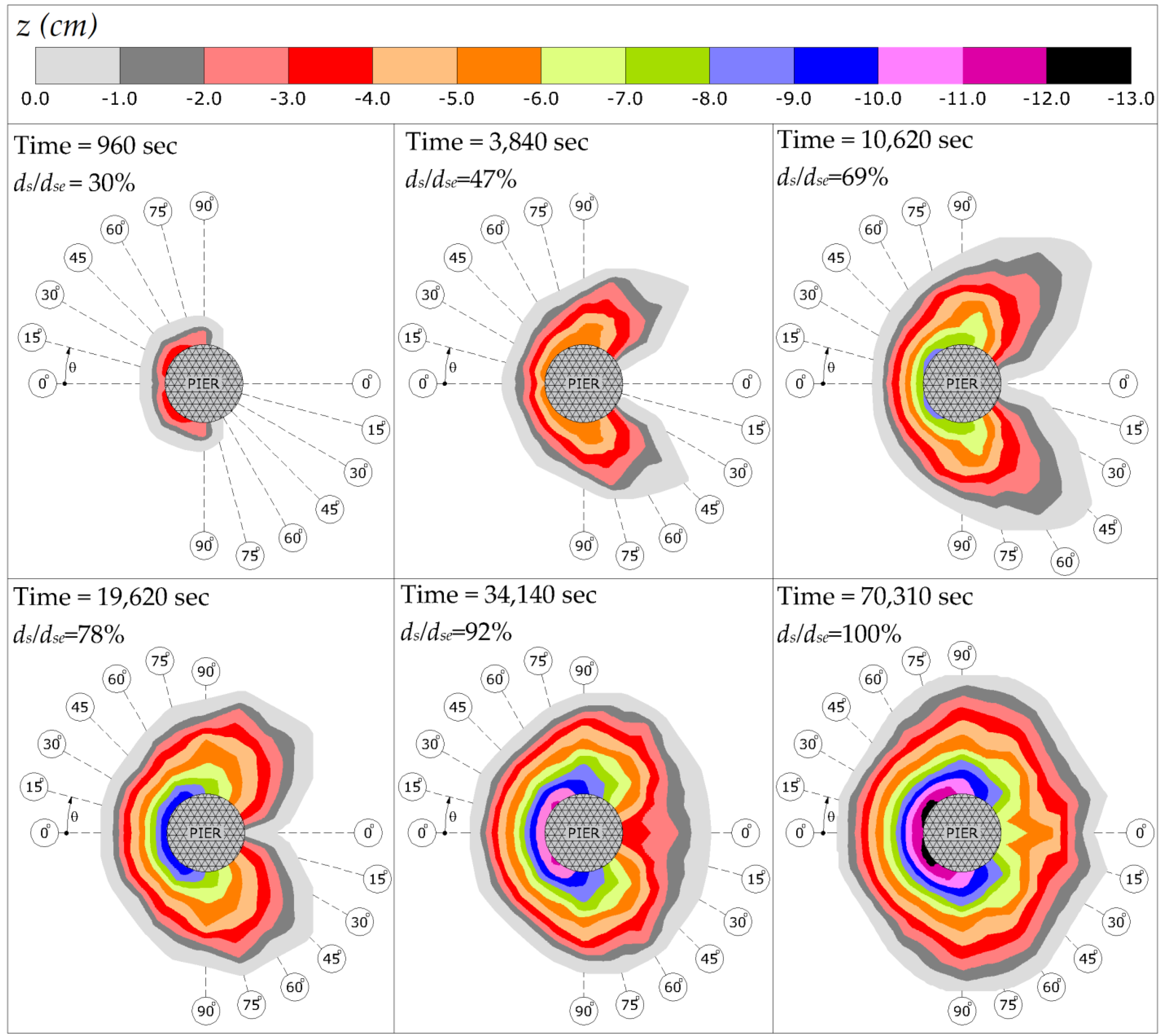
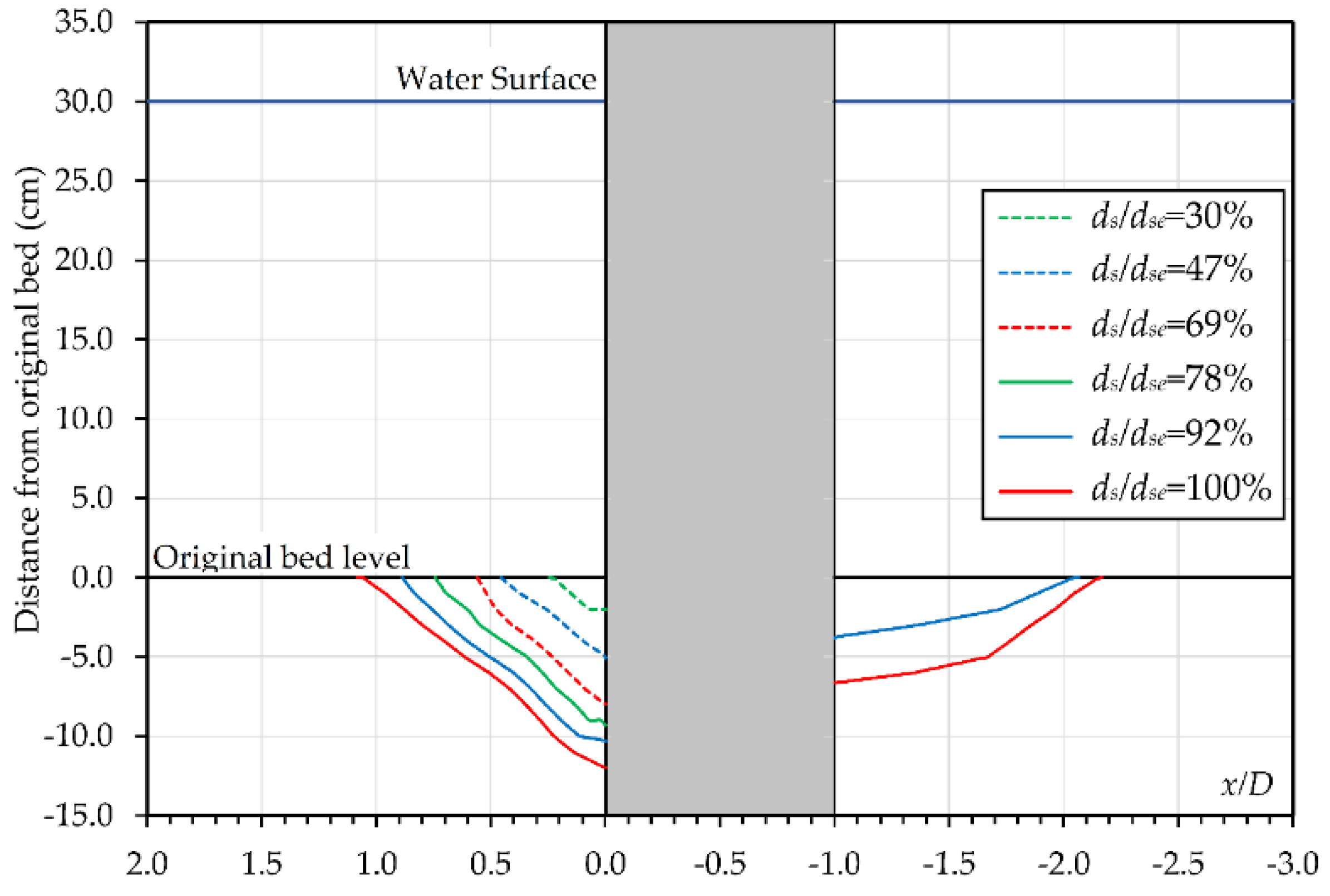

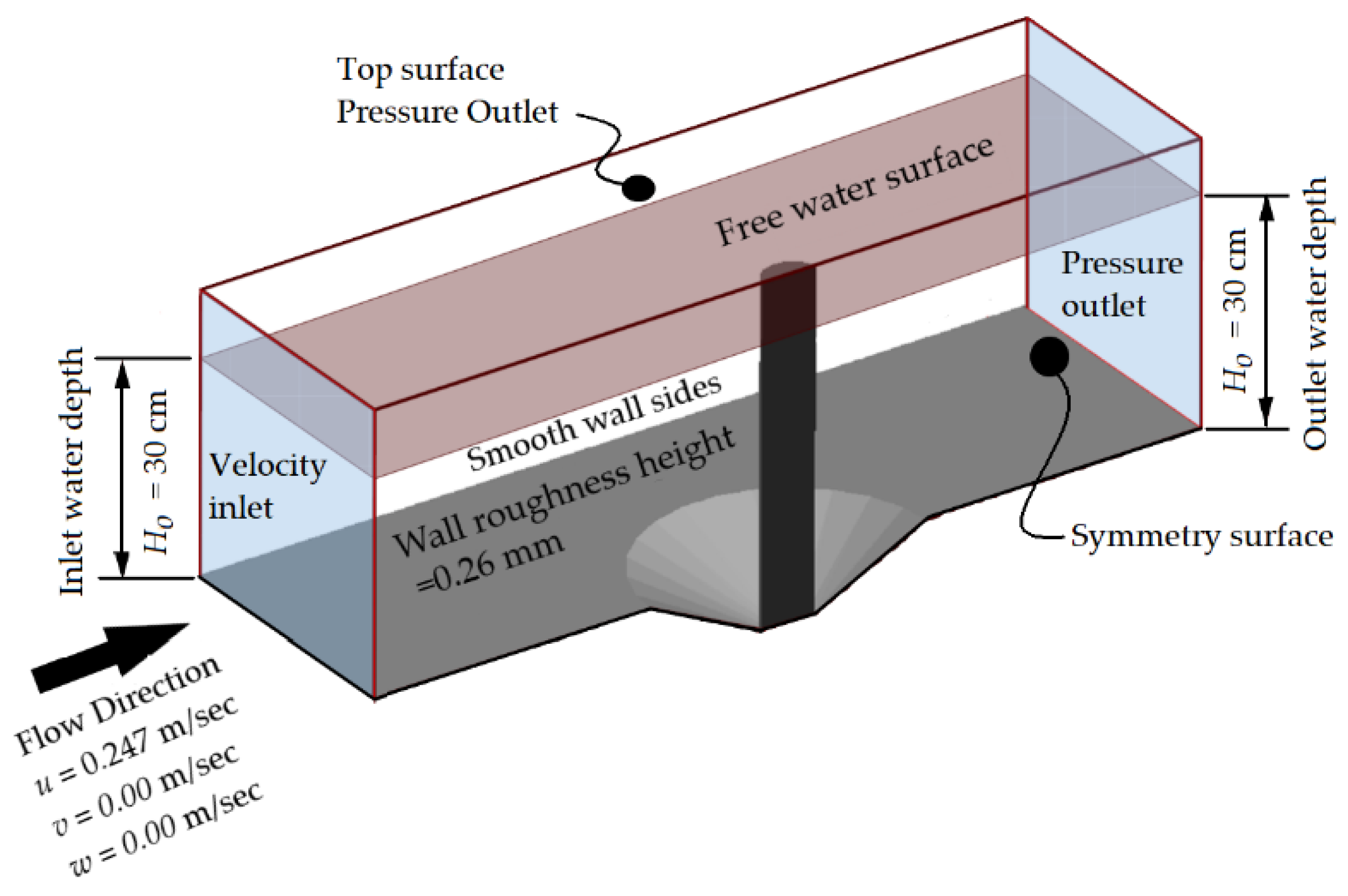
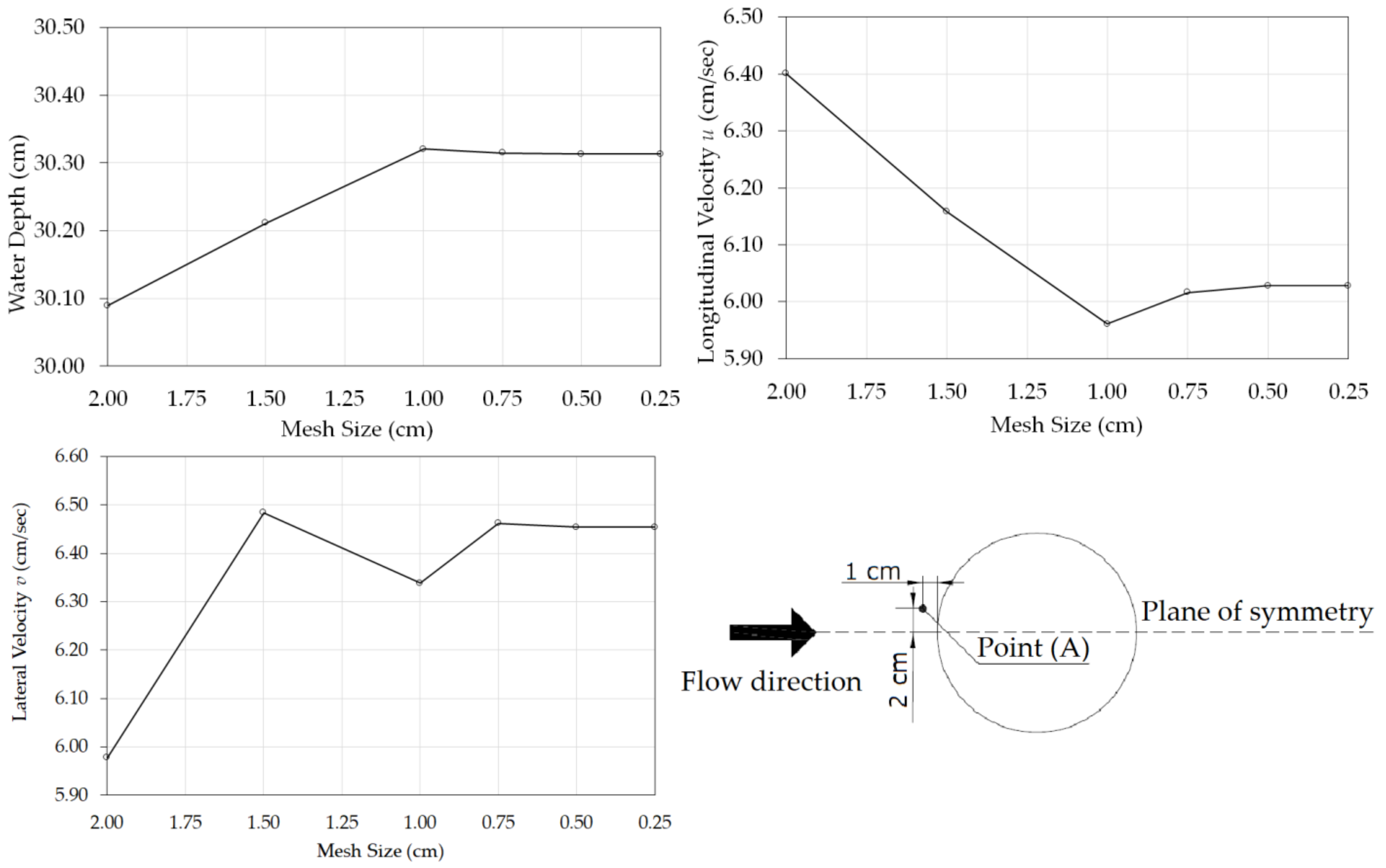
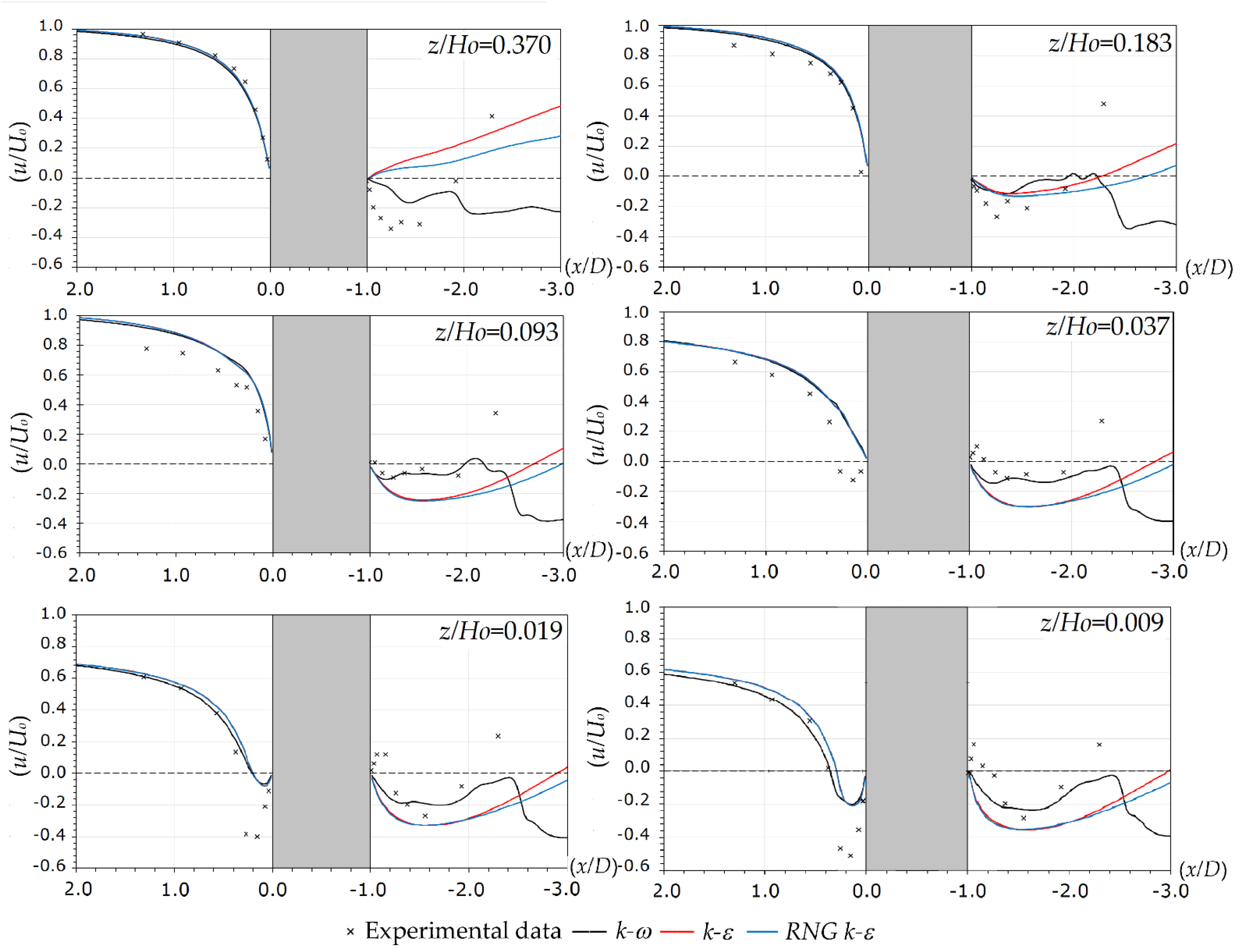
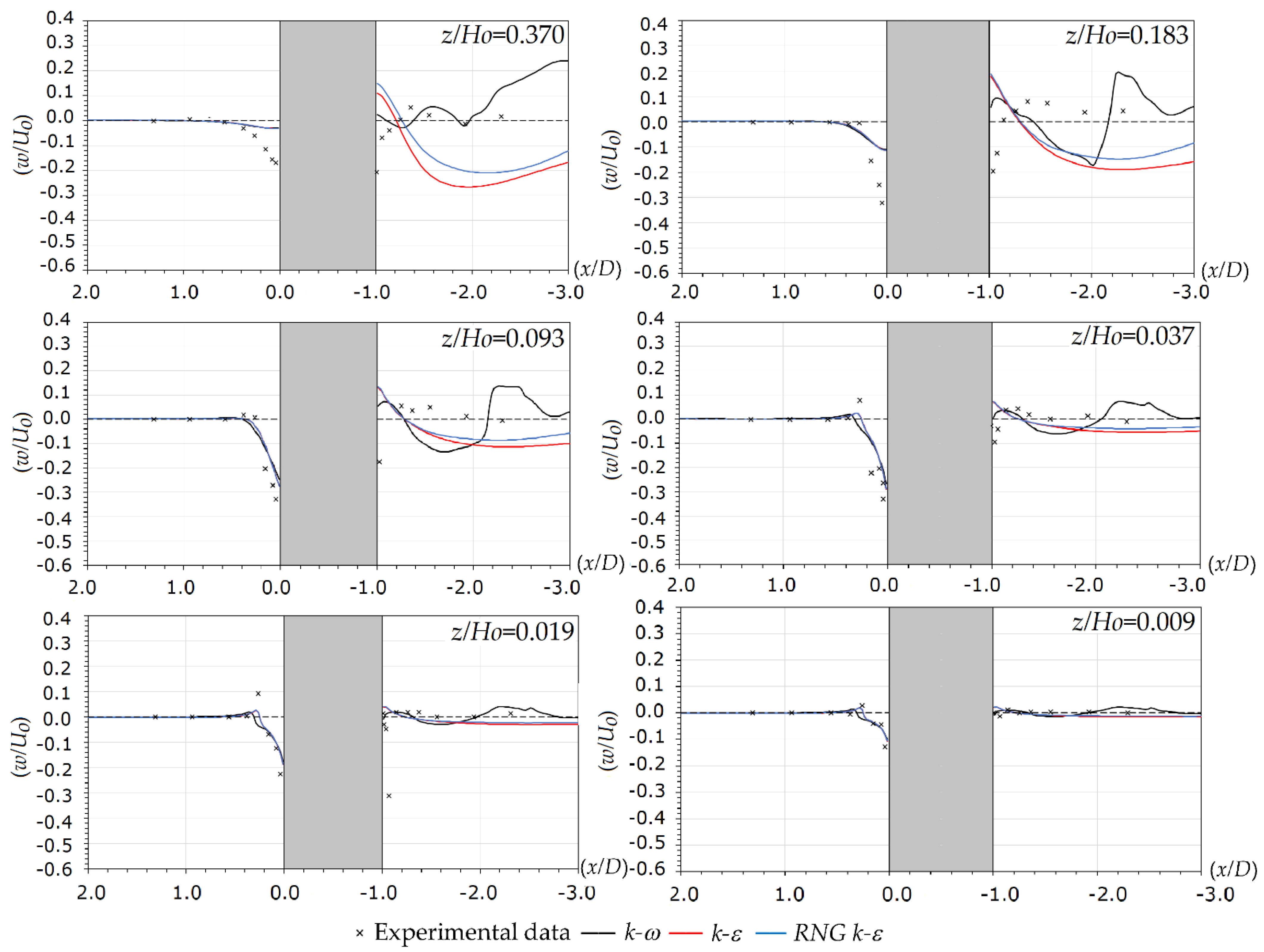
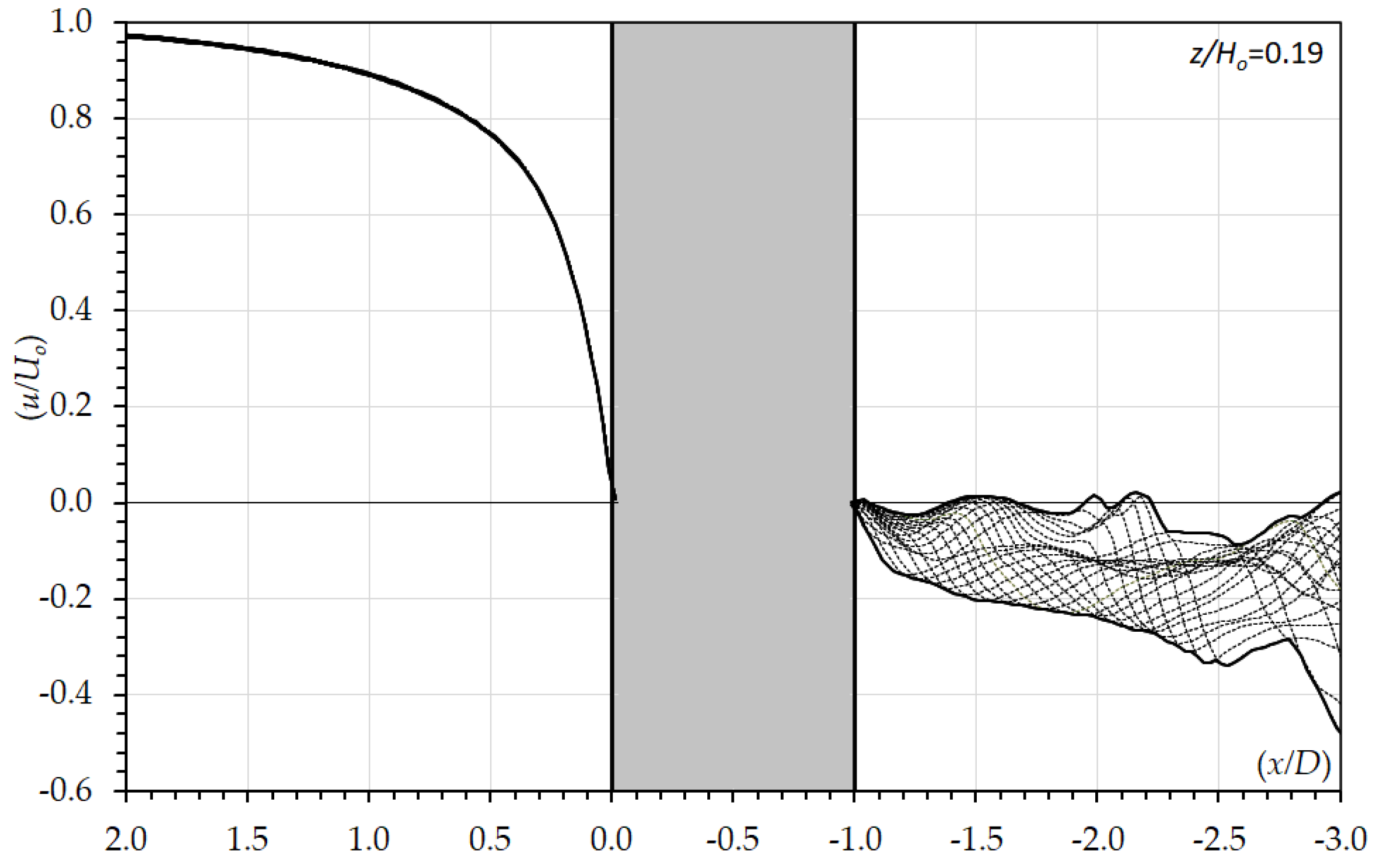
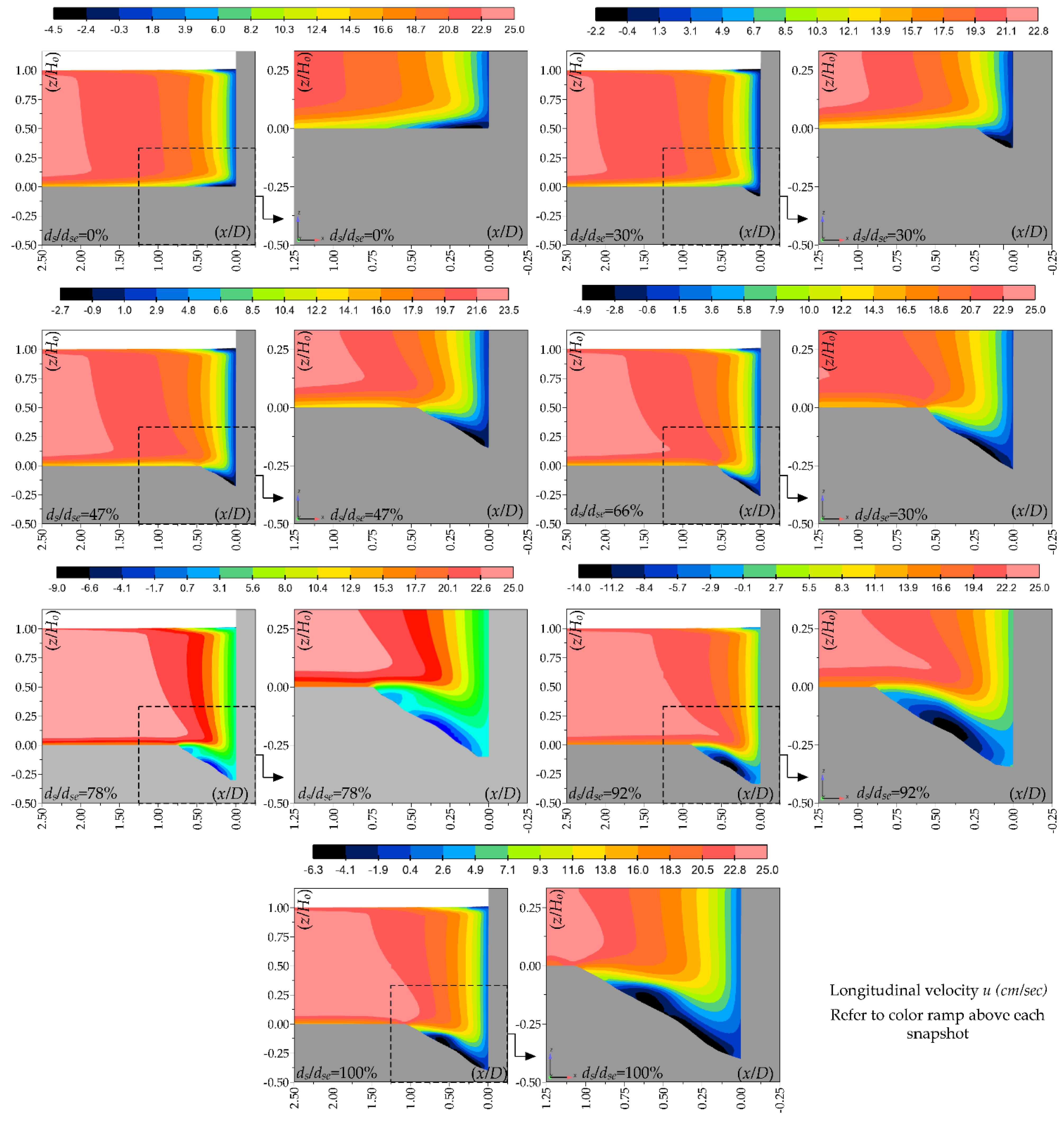
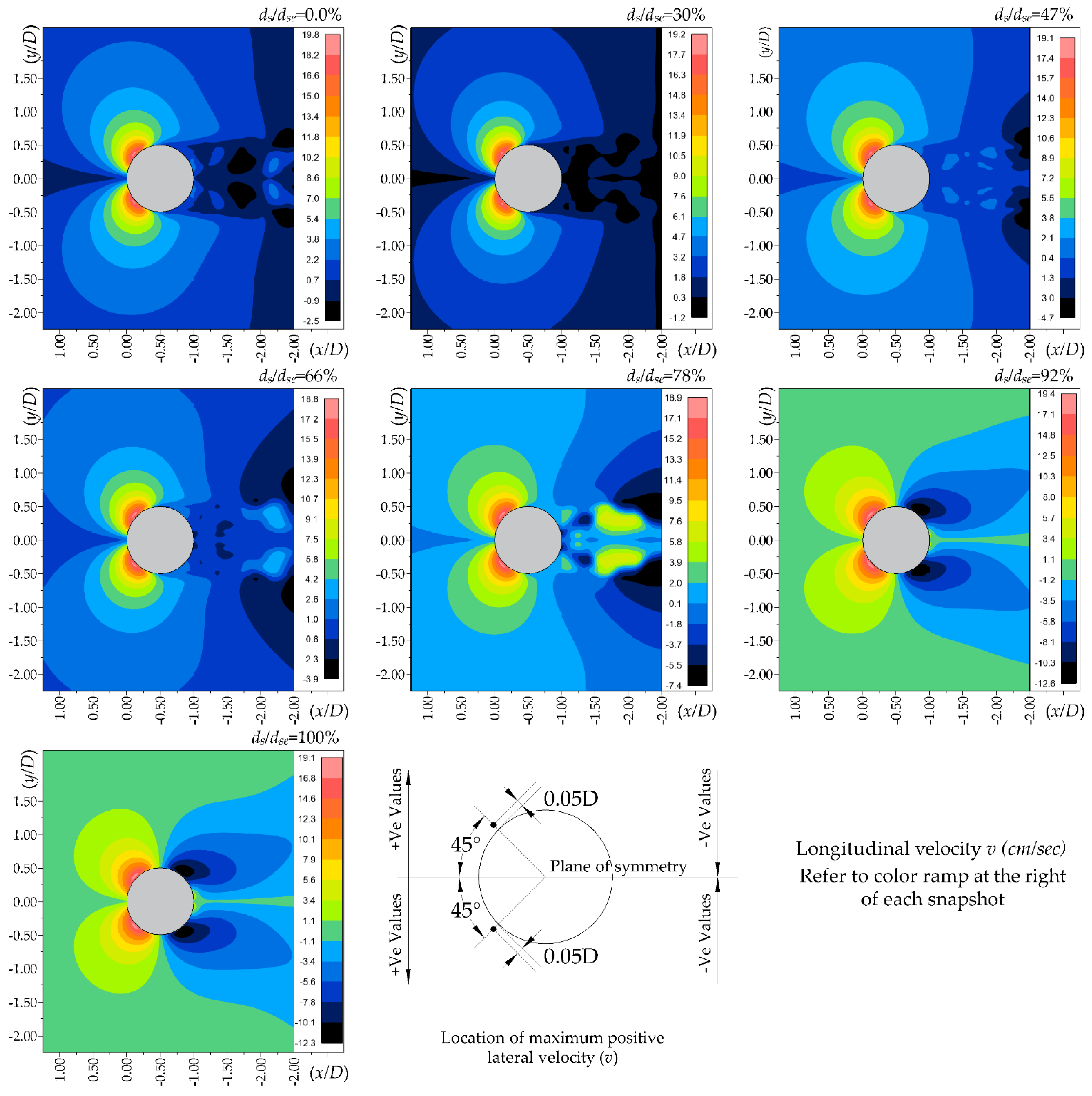
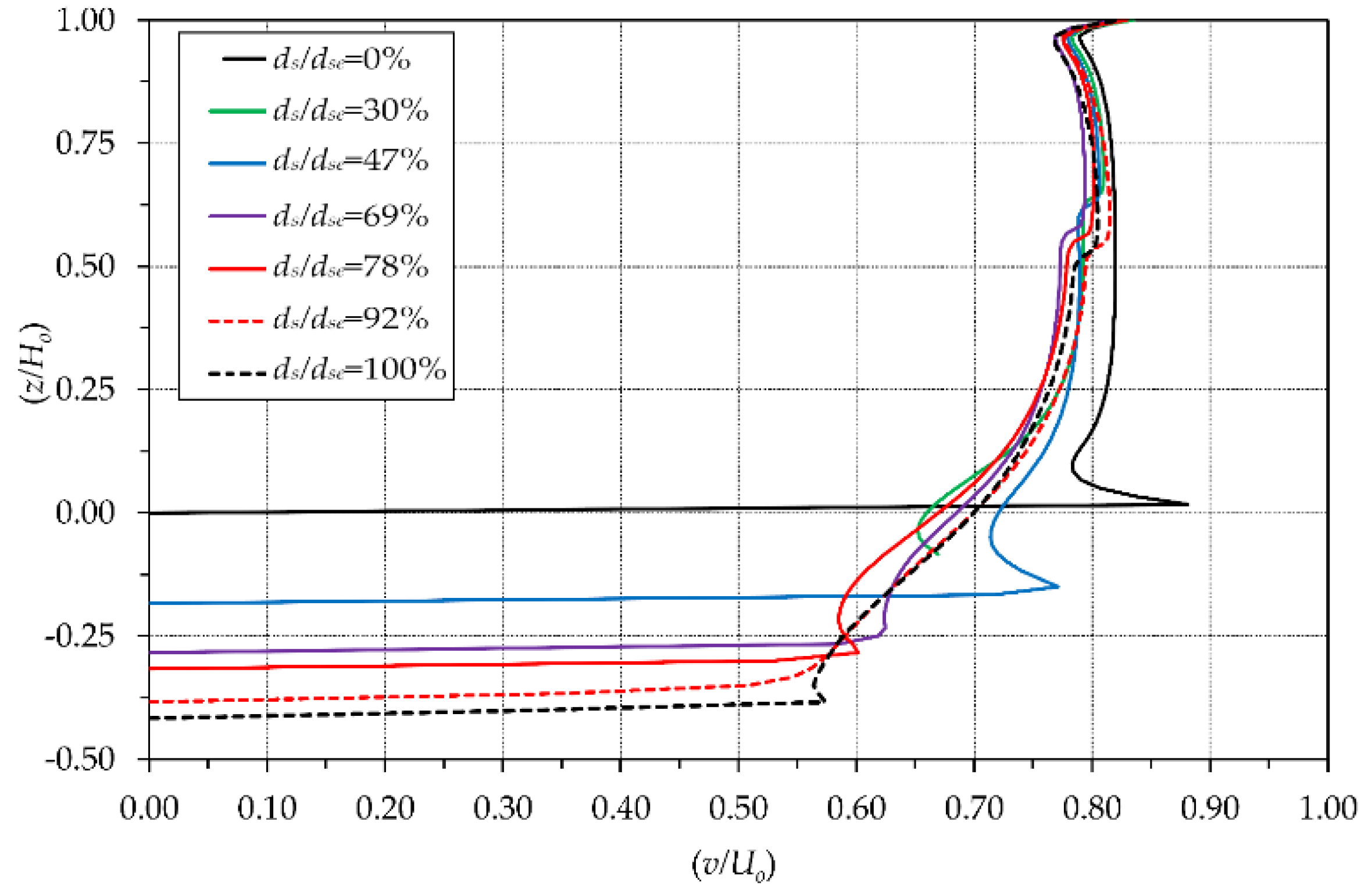
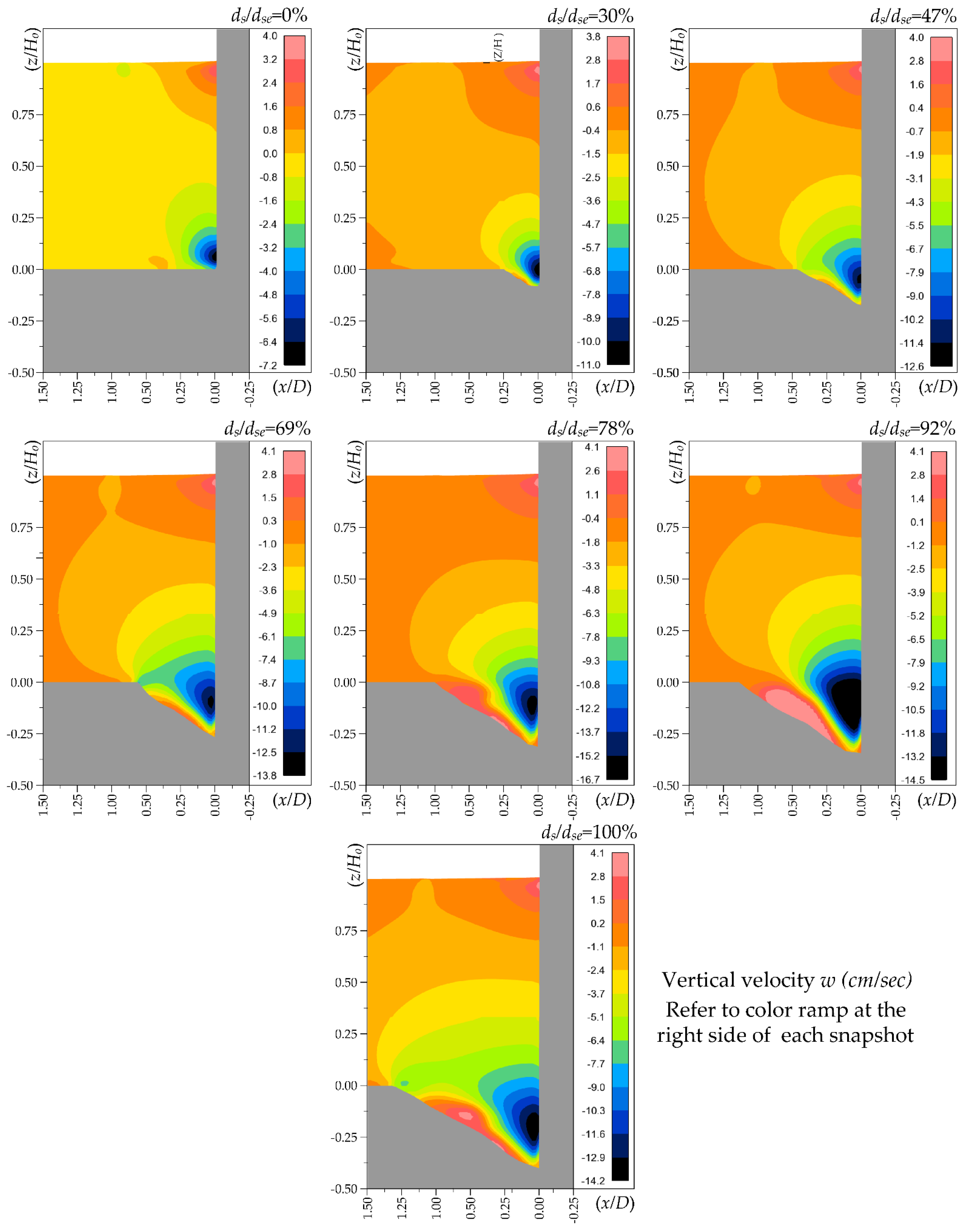
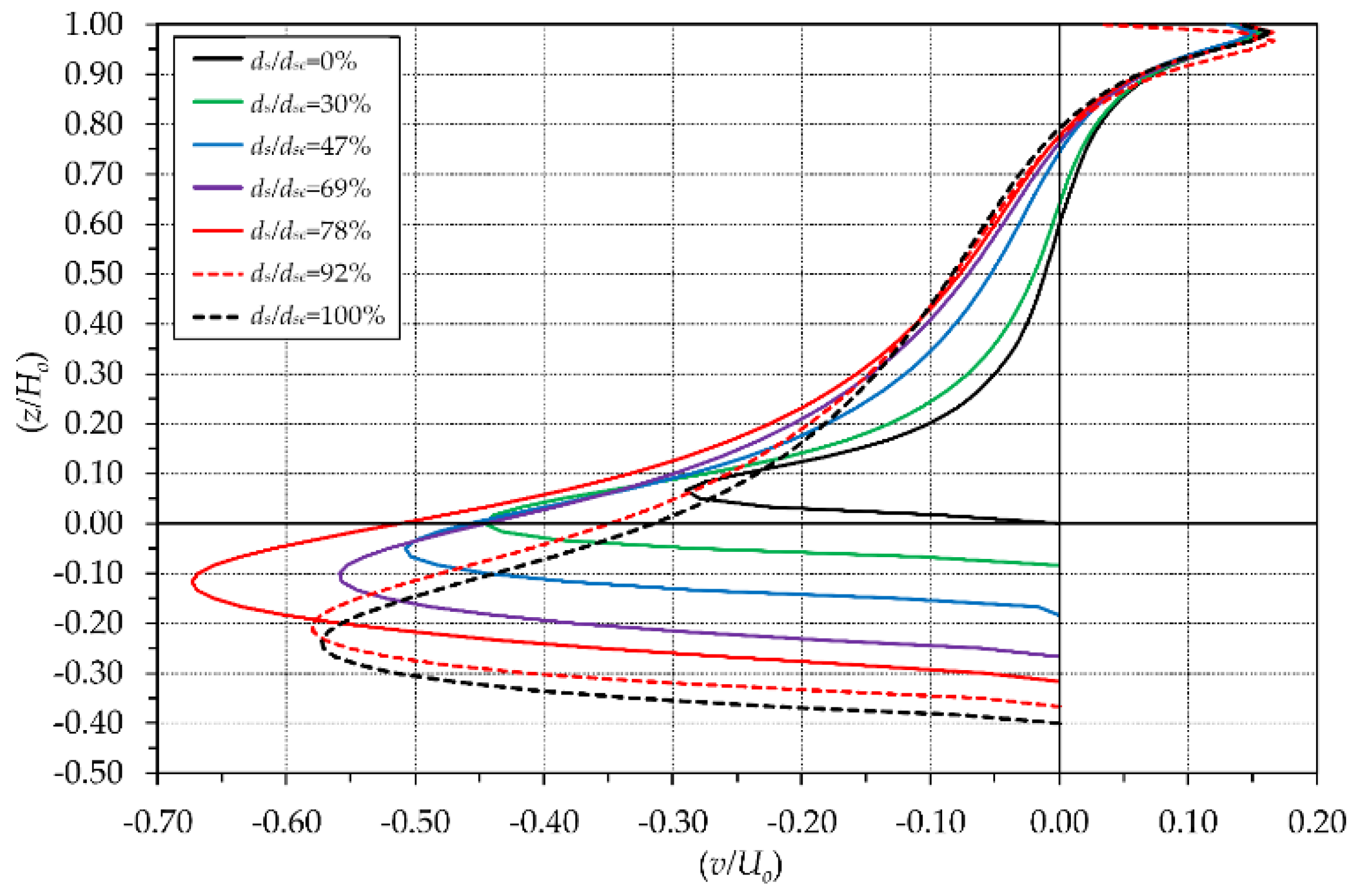
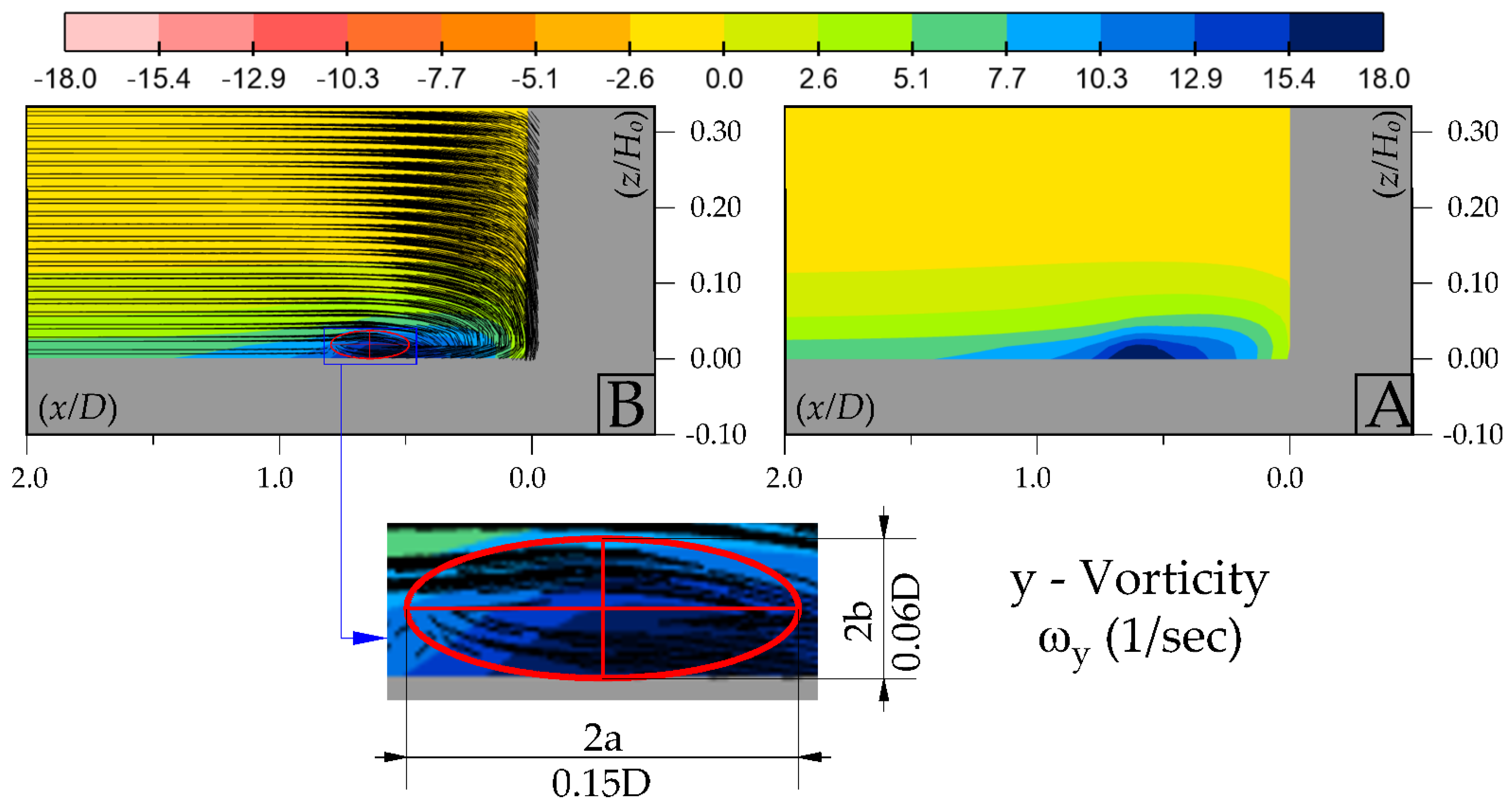
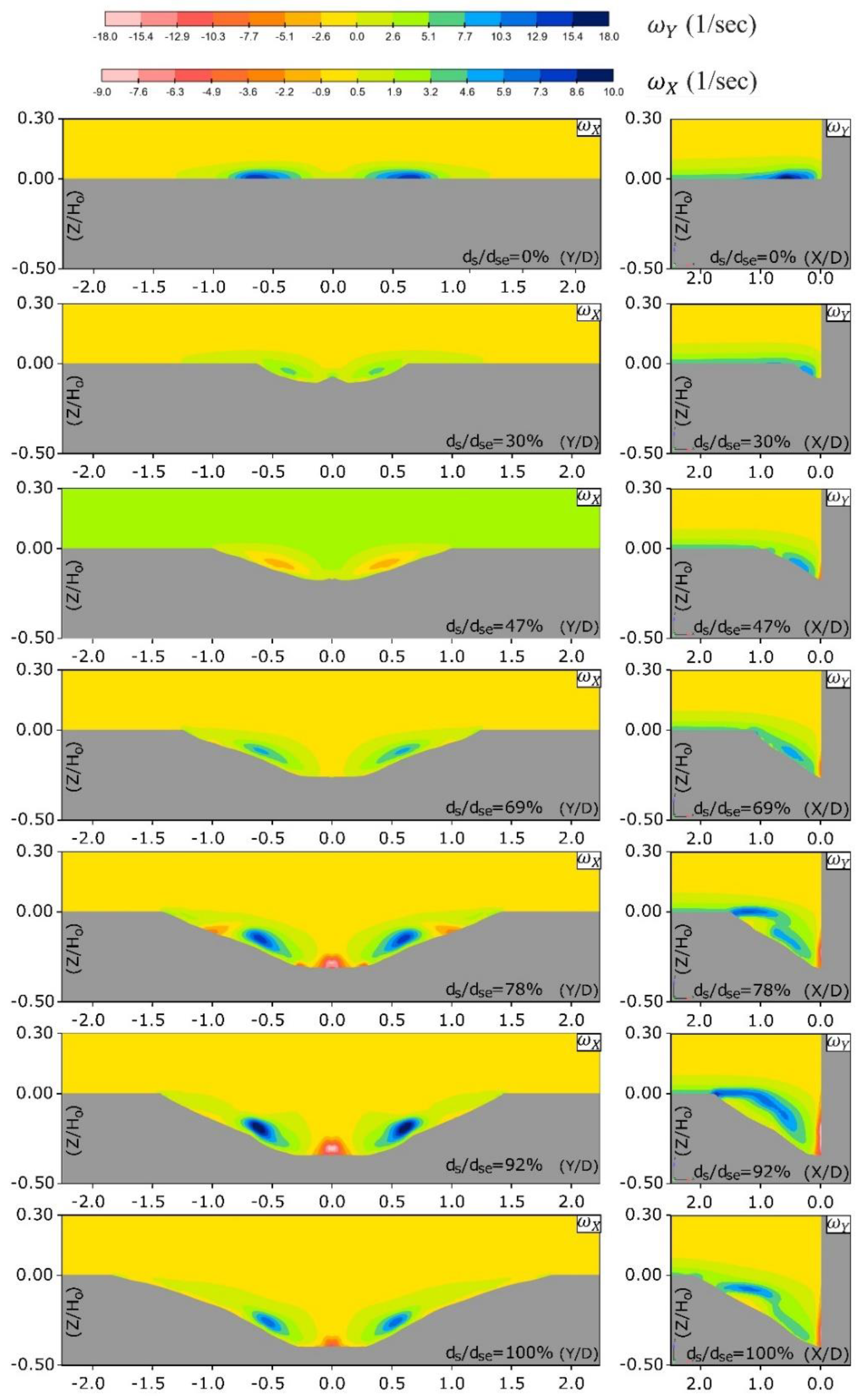

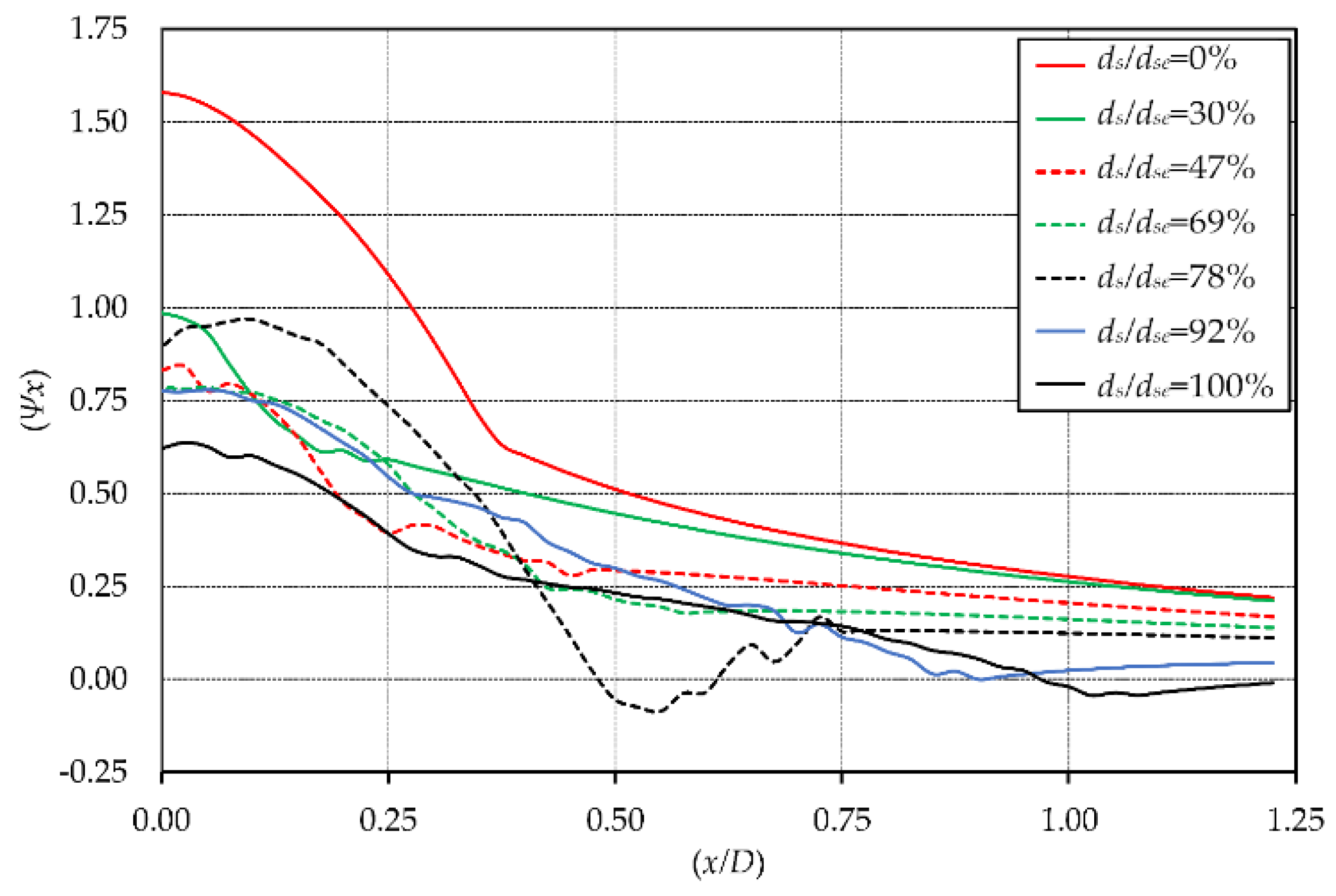
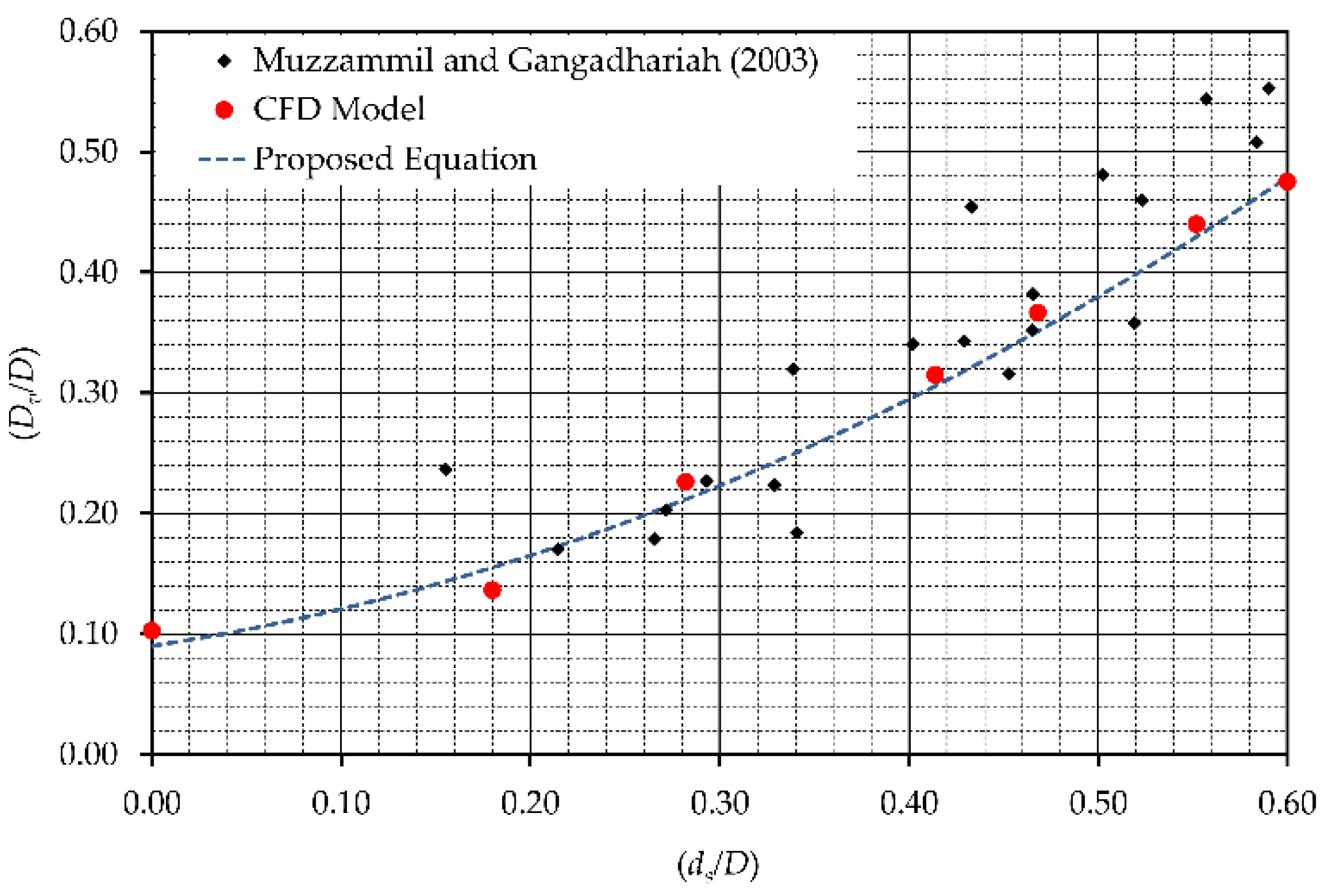
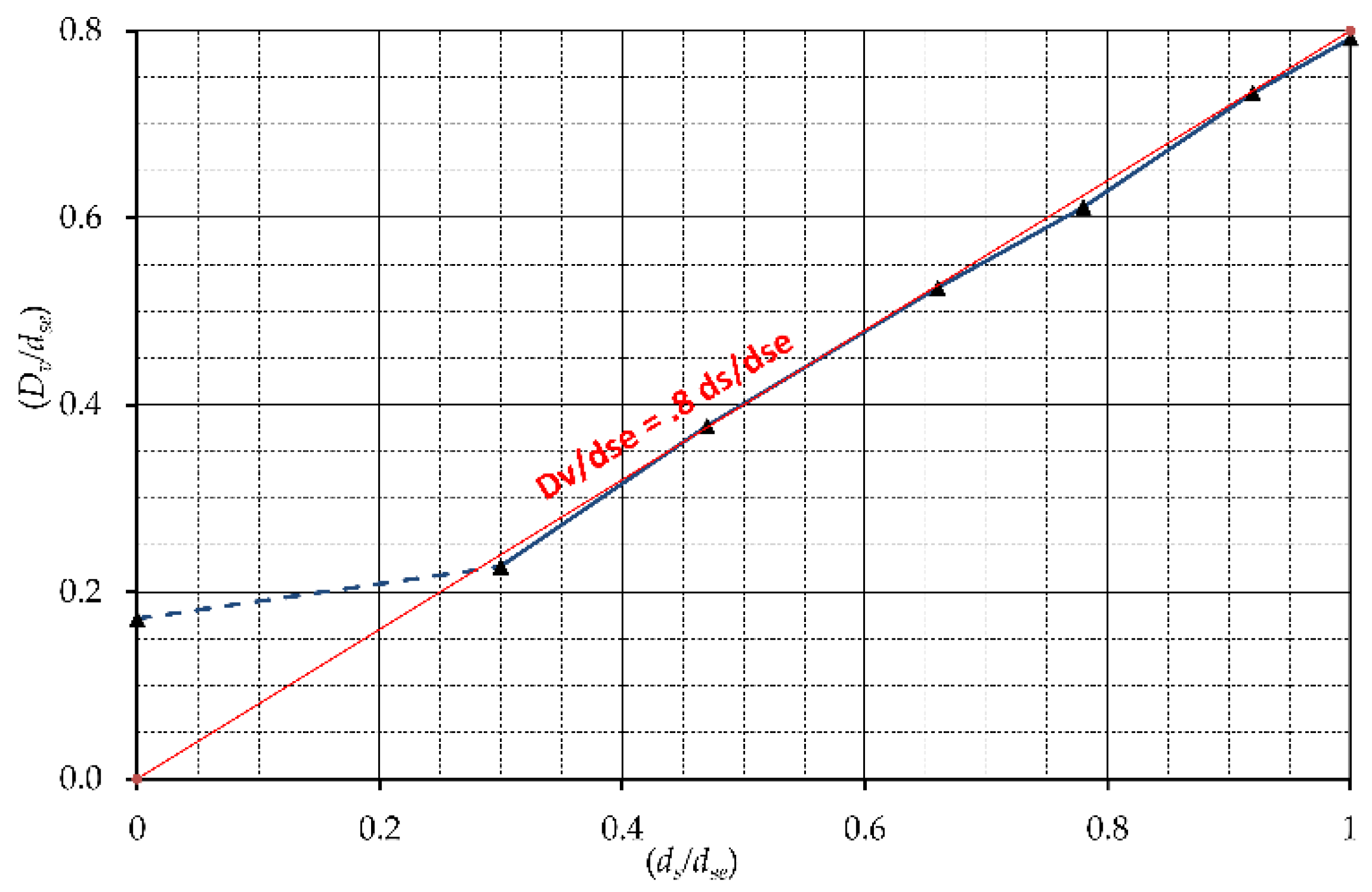
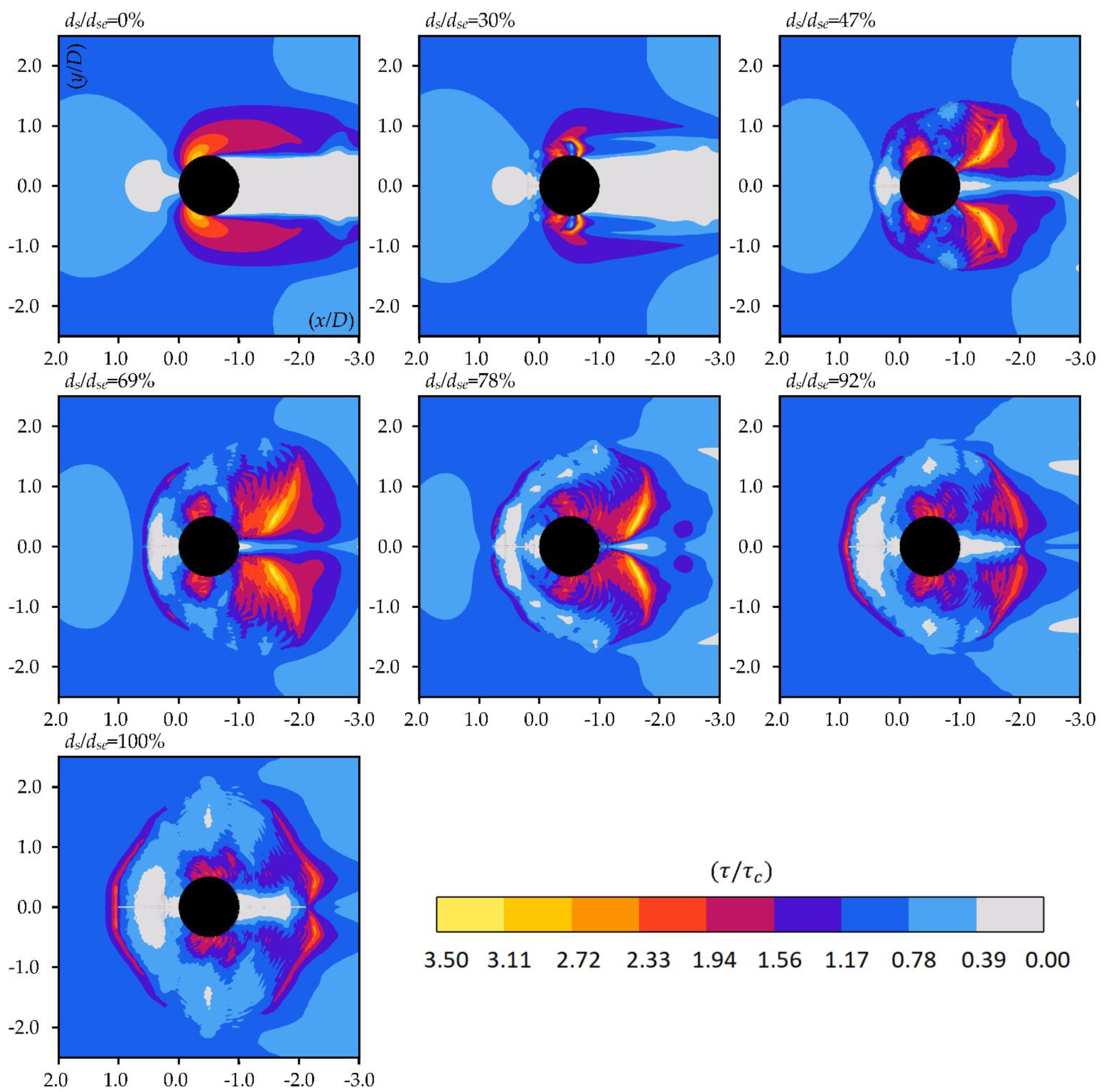
| Run Number | Total Domain Cells | Fluid Sub Domain Cells | Solid Sub Domain Cells | Partially Wet Cells |
|---|---|---|---|---|
| 1-(ds/dse = 0.00%) | 13,764,080 | 8,870,812 | 179,306 | 4,713,962 |
| 2-(ds/dse = 30.0%) | 13,764,080 | 8,874,962 | 180,935 | 4,708,183 |
| 3-(ds/dse = 47.0%) | 13,764,080 | 8,888,140 | 184,195 | 4,691,745 |
| 4-(ds/dse = 69.0%) | 13,764,080 | 8,903,531 | 187,177 | 4,673,372 |
| 5-(ds/dse = 78.0%) | 13,764,080 | 8,910,260 | 187,515 | 4,666,305 |
| 6-(ds/dse = 92.0%) | 13,764,080 | 8,922,547 | 188,995 | 4,652,538 |
| 7-(ds/dse = 100.0%) | 13,764,080 | 8,940,817 | 191,613 | 4,631,650 |
Publisher’s Note: MDPI stays neutral with regard to jurisdictional claims in published maps and institutional affiliations. |
© 2021 by the authors. Licensee MDPI, Basel, Switzerland. This article is an open access article distributed under the terms and conditions of the Creative Commons Attribution (CC BY) license (https://creativecommons.org/licenses/by/4.0/).
Share and Cite
Helmi, A.M.; Shehata, A.H. Three-Dimensional Numerical Investigations of the Flow Pattern and Evolution of the Horseshoe Vortex at a Circular Pier during the Development of a Scour Hole. Appl. Sci. 2021, 11, 6898. https://doi.org/10.3390/app11156898
Helmi AM, Shehata AH. Three-Dimensional Numerical Investigations of the Flow Pattern and Evolution of the Horseshoe Vortex at a Circular Pier during the Development of a Scour Hole. Applied Sciences. 2021; 11(15):6898. https://doi.org/10.3390/app11156898
Chicago/Turabian StyleHelmi, Ahmed M., and Ahmed H. Shehata. 2021. "Three-Dimensional Numerical Investigations of the Flow Pattern and Evolution of the Horseshoe Vortex at a Circular Pier during the Development of a Scour Hole" Applied Sciences 11, no. 15: 6898. https://doi.org/10.3390/app11156898
APA StyleHelmi, A. M., & Shehata, A. H. (2021). Three-Dimensional Numerical Investigations of the Flow Pattern and Evolution of the Horseshoe Vortex at a Circular Pier during the Development of a Scour Hole. Applied Sciences, 11(15), 6898. https://doi.org/10.3390/app11156898







